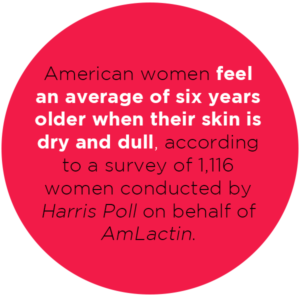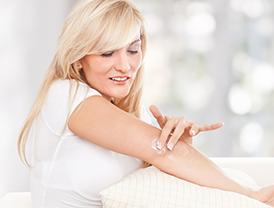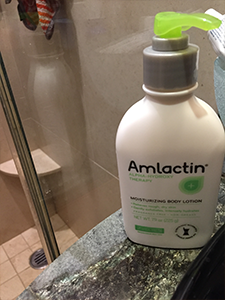This post is sponsored by AmLactin.
A baby’s skin is so soft and smooth, it’s hard to resist kissing every inch of it, from the soles of his feet, to his tiny baby butt, right up to his delicious plump cheeks!


Why, oh why, can’t our skin stay as alluring throughout our lives?
WHY? Because a zillion unavoidable factors affect the way our skin looks and feels, and if we don’t take care of it, we’re pretty sure to develop rough, dry, flaky and itchy skin. Well, maybe a zillion things don’t affect it, but a whole bunch do, the most significant being:

When we’re young, the outer layers of the skin, called the epidermis, are supported by the lower layers, called the dermis, where collagen formation takes place. Collagen impacts the way our skin looks and feels because it is the main structural component providing firmness and shape.
Factors, including too much unprotected sun exposure over a lifetime, weaken our cells that produce collagen.

This can result in dead skin cells building up on the skin’s surface, which give it a rougher look and feel.

 Natural lipids decrease (molecules containing cholesterol, fatty acids and ceramides) in the more vulnerable outer skin, which can make it harder to keep skin moist. When the balance of the skin’s protective barrier is upset, the skin becomes more susceptible to environmental factors and other irritants. Skin owes its soft, pliable texture to its water content. Dry air (low humidity), probably the most common cause of dry skin, causes reduced water content.
Natural lipids decrease (molecules containing cholesterol, fatty acids and ceramides) in the more vulnerable outer skin, which can make it harder to keep skin moist. When the balance of the skin’s protective barrier is upset, the skin becomes more susceptible to environmental factors and other irritants. Skin owes its soft, pliable texture to its water content. Dry air (low humidity), probably the most common cause of dry skin, causes reduced water content.
Harsh soaps, scratchy clothing, long, hot showers or baths, hot or cold weather with low humidity, and constant exposure to air conditioning also can trigger lipid depletion.

These can occur in menopause and can also cause severe skin dryness.
It’s wisest to start protecting your skin as early as your 20s, so make sure to tell your nieces and daughters to get started. But for those of us who are FabOverFifty, it is definitely not too late to begin a smart body skin care routine. The steps are quick and easy. No excuses!
 Step One: Take a warm (never hot) bath or shower.
Step One: Take a warm (never hot) bath or shower.
Step Two: Avoid using perfumed soaps on your body, which can be terribly drying. Instead use washes that are loaded with moisturizing ingredients, such as shea butter, vitamin E and jojoba oil.
Step Three: Moisturize immediately after bathing or showering, when your skin is damp, and before bedtime, using creams and lotions containing skin barrier strengthening ceramides and multitasking alpha-hydroxy acids. Alpha-hydroxy acids have a special ability to not only exfoliate away dry, dead skin cells, but also to deeply hydrate for long-lasting moisture.
Every product in AmLactin’s line of lotions and body creams contains this multitasking alpha-hydroxy therapy.
 According to the company, AmLactin moisturizers are “especially effective at gently exfoliating your skin, and their creamy emollients have the amazing ability to help your skin retain moisture and make it feel soft and smooth.” The four products are formulated to tackle a range of skin concerns: The Moisturizing Body Lotion can be used daily all over the body to relieve rough, dry skin and intensely hydrates. The Cerapeutic Restoring Body Lotion helps heal extremely rough, flaky, dry skin, and its ceramides help restore the skin’s natural barrier. Applying it to your décolletage can help reduce the appearance of crepey skin. The Ultra Hydrating Body Cream, smooths, repairs and softens severely and persistently dry skin—the kind you might find on your hands, elbows, and knees. There’s also a clinical-strength Foot Cream to smooth rough, cracked and callused feet.
According to the company, AmLactin moisturizers are “especially effective at gently exfoliating your skin, and their creamy emollients have the amazing ability to help your skin retain moisture and make it feel soft and smooth.” The four products are formulated to tackle a range of skin concerns: The Moisturizing Body Lotion can be used daily all over the body to relieve rough, dry skin and intensely hydrates. The Cerapeutic Restoring Body Lotion helps heal extremely rough, flaky, dry skin, and its ceramides help restore the skin’s natural barrier. Applying it to your décolletage can help reduce the appearance of crepey skin. The Ultra Hydrating Body Cream, smooths, repairs and softens severely and persistently dry skin—the kind you might find on your hands, elbows, and knees. There’s also a clinical-strength Foot Cream to smooth rough, cracked and callused feet.
AmLactin is available at CVS stores as well as on Amazon.com. Don’t forget to follow AmLactin on Facebook and Twitter for promotions, giveaways, and product news!
Uncover smooth, radiant skin with AmLactin Alpha-Hydroxy Skin Care. Its unique exfoliating and hydrating alpha-hydroxy therapy gently removes dead skin cells and thoroughly moisturizes. It’s the difference between skin care and skin therapy. Look for AmLactin moisturizers at your local Target, CVS, Walgreens, Costco, Walmart and Rite Aid.
This is a sponsored conversation written by me on behalf of AmLactin. The opinions and text are my own.

